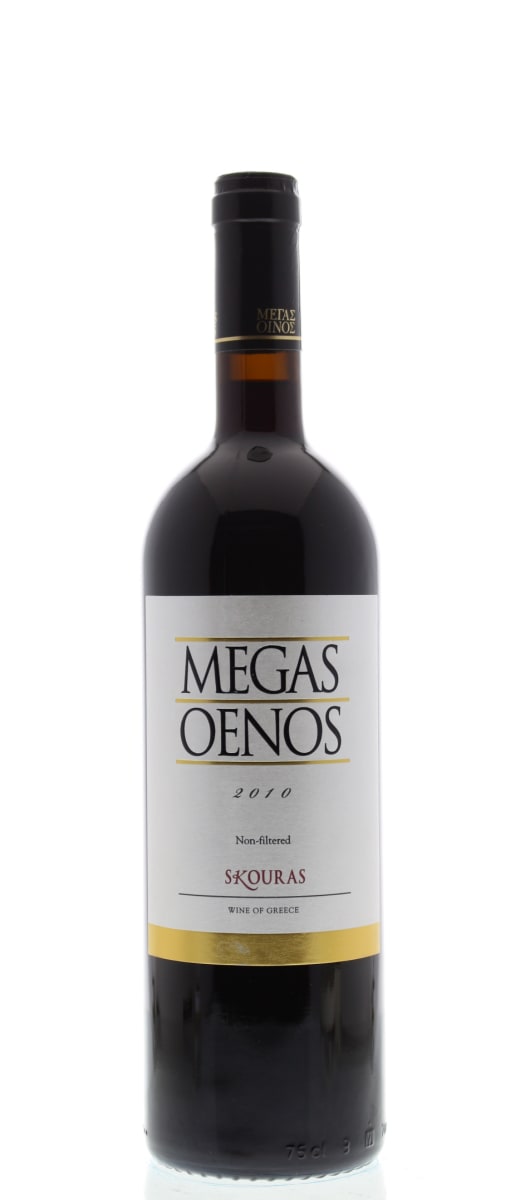Skouras Megas Oenos Red 2010
-
Wine &
Spirits -
Robert
Parker




Product Details
Your Rating
Somm Note
Winemaker Notes
Blend: 80% Agiorgitiko, 20% Cabernet Sauvignon
Professional Ratings
-
Wine & Spirits
Although the name, “big wine,” suggests a bruiser, this 2010 is one of the most graceful vintages of Megas Oenos in recent memory. Sure, it’s dark and generously fruited, but the fruit comes in layers, scents of earth, spice and fir trees bringing to mind the scent of Nemea’s higher, cooler elevations. There’s some vanilla from oak, and 20 percent cabernet blended in to bolster the agiorgitiko, but the wine feels firm and savory, an elegant version of a modern Nemean red.
-
Robert Parker's Wine Advocate
The 2010 Megas Oenos is the typical blend of Cabernet Sauvignon (20%) and old vines Agiorgitiko (80%). There was one notable change here, though: less oak impact. It was aged in French oak for 18 months (50% new, the rest second use). Completely undeveloped, it nonetheless seems like a perfectly constructed Megas Oenos, tight at the moment, but certain to evolve well; a bit too oaky just now, but likely to pull itself together perfectly; elegant, but subtly concentrated. It is an impressive performance that might eventually make it "best in show", although it is a lot easier to give that nod to the more developed 2006 at the moment. Give this 3-5 years of cellaring, though, to show what it has. After holding it open for a couple of hours, it was far better and came together well. It should age well. I opened this at 7:30 a.m. I began to play with it around 8:45 a.m. It was far better at 1:30 p.m. Drink 2016-2030.
Other Vintages
2019-
Robert
Parker
-
James
Suckling -
Robert
Parker
-
Robert
Parker
-
Wine &
Spirits
-
Robert
Parker
-
Robert
Parker
-
Robert
Parker
-
Robert
Parker

With hundreds of red grape varieties to choose from, winemakers have the freedom to create a virtually endless assortment of blended red wines. In many European regions, strict laws are in place determining the set of varieties that may be used, but in the New World, experimentation is permitted and encouraged resulting in a wide variety of red wine styles. Blending can be utilized to enhance balance or create complexity, lending different layers of flavors and aromas. For example, a red wine blend variety that creates a fruity and full-bodied wine would do well combined with one that is naturally high in acidity and tannins. Sometimes small amounts of a particular variety are added to boost color or aromatics. Blending can take place before or after fermentation, with the latter, more popular option giving more control to the winemaker over the final qualities of the wine.
How to Serve Red Wine
A common piece of advice is to serve red wine at “room temperature,” but this suggestion is imprecise. After all, room temperature in January is likely to be quite different than in August, even considering the possible effect of central heating and air conditioning systems. The proper temperature to aim for is 55° F to 60° F for lighter-bodied reds and 60° F to 65° F for fuller-bodied wines.
How Long Does Red Wine Last?
Once opened and re-corked, a bottle stored in a cool, dark environment (like your fridge) will stay fresh and nicely drinkable for a day or two. There are products available that can extend that period by a couple of days. As for unopened bottles, optimal storage means keeping them on their sides in a moderately humid environment at about 57° F. Red wines stored in this manner will stay good – and possibly improve – for anywhere from one year to multiple decades. Assessing how long to hold on to a bottle is a complicated science. If you are planning long-term storage of your reds, seek the advice of a wine professional.

A picturesque Mediterranean nation with a rich wine culture dating back to ancient times, Greece has so much more to offer than just retsina. Between the mainland and the country’s many islands, a wealth of Greek wine styles exists, made mostly from Greece’s plentiful indigenous varieties. After centuries of adversity after Ottoman rule, the modern Greek wine industry took off in the late 20th century with an influx of newly trained winemakers and investments in winemaking technology.
The climate—generally hot Mediterranean—can vary a bit with latitude and elevation, and is mostly moderated by cool maritime breezes. Drought can be an issue for Greek wine during the long, dry summers, sometimes necessitating irrigation.
Over 300 indigenous grapes have been identified throughout Greece, and though not all of them are suitable for wine production, future decades will likely see a significant revival and refinement of many of these native Greek wine varieties. Assyrtiko, the crisp, saline Greek wine variety of the island of Santorini, is one of the most important and popular white wine varieties, alongside Roditis, Robola, Moschofilero, and Malagousia. Muscat is also widely grown for both sweet and dry wines. Prominent red wine varieties include full-bodied and fruity Agiorghitiko, native to Nemea; Macedonia’s savory, tannic Xinomavro; and Mavrodaphne, used commonly to produce a Port-like fortified wine in the Peloponnese.





